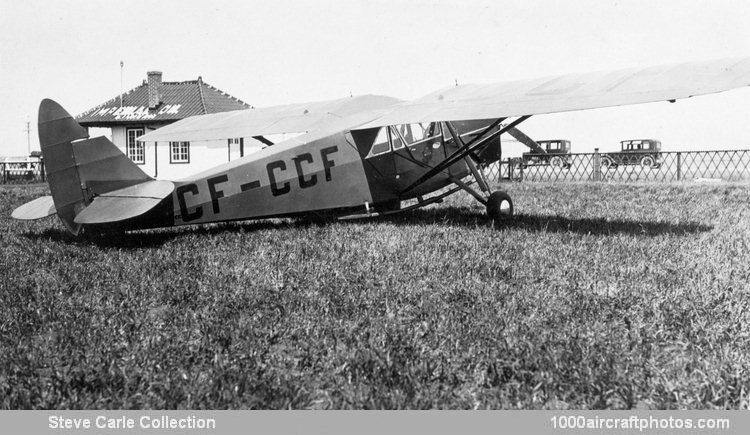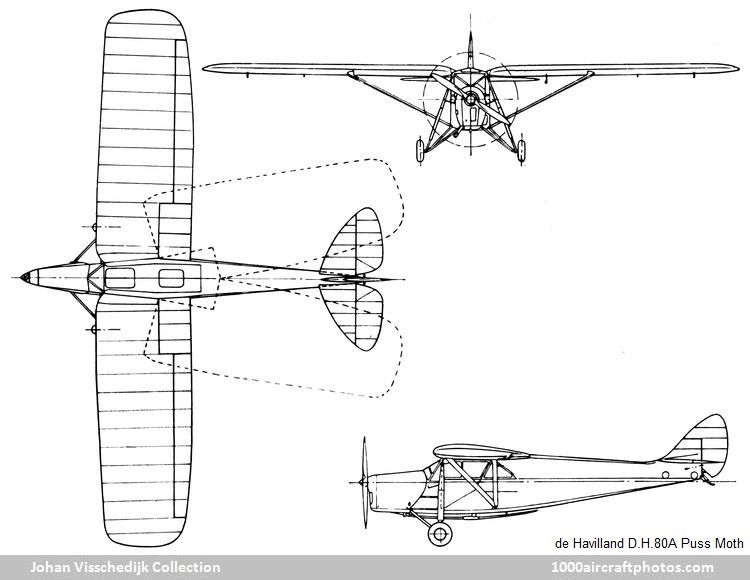01/31/2020. Remarks by Johan Visschedijk: "Following the success of the basic D.H.60 Moth, many owners began venturing farther afield, highlighting the need for a two to three-seat cabin tourer with room for overnight luggage. The initial attempt at this requirement was the all-wood D.H.80 with ply-covered fuselage and fabric covered high monoplane wing. This was the first aircraft to feature the inverted de Havilland Gipsy III engine giving a better view and reduced drag.
The prototype D.H.80, registered G-AAHZ (c/n 396), was first flown on September 9, 1929. Despite the good performance of the unnamed prototype it did not enter production, as the more robust metal structure was essential for successful sales and longer life. The new version, known as the D.H.80A Puss Moth, had a welded steel tube fuselage, and the fabric covered wooden-structured wings folded back to save hangar space. Airbrakes had to be fitted on the landing gear fairings to increase drag for landing.
The Puss Moth soon became popular with private owners and flying clubs, as well as being used to open up regular passenger and mail services, charter, business flying, survey and military communications. Fry's Chocolate used one for business, Hillman Airways started services with three, and the Iraqi AF fitted racks for four 20 lb (9 kg) bombs to their three D.H.80As.
Early in its career there were a number of unexplained fatal accidents to Puss Moths, often in remote areas, which were caused by structural failure of the wings. After a thorough investigation, it was found that a combination of high speed and turbulence could cause wing failure, which was easily cured by adding a strut connecting the forward wing strut with the rear wing root.
Some notable long distance flights were made including the crossing of both the North and South Atlantic. For the first, Jim Mollison flew a specially modified Puss Moth named The Hearts Content with a 90 gal (341 l) tank in the front part of the cabin and a 50.5 gal (191 l) tank in the rear, giving a range of 3,600 mls (5,794 km), or duration of 33 hours. A suitably long take off site was found in Ireland, commencing the flight on August 18, 1932 against the prevailing winds to the USA. After landfall, Mollison flew on hoping to reach New York, but had to land in New Brunswick due to shortage of fuel and exhaustion. He had flown 2,600 mls (4,184 km) in an elapsed time of 30 hours and 15 minutes.
Bert Hinkler, the Australian pioneer flew from New York to London, England, via the South Atlantic in a Puss Moth, landing in England on 7 December 1931. He set off again from London on January 7, 1933, to attempt a record-breaking flight to Australia, but crashed in the Apennine Mountains in Italy, a victim of wing failure. Another Australian, C. J. Melrose, flew his Puss Moth to Britain for the MacRobertson Air Race leaving Mildenhall on October 20, 1934. Despite the strong competition he gained third place in the handicap section at an average speed of 103 mph (166 kmh).
HRH the Prince of Wales was one of many Puss Moth owners, and altogether he owned four over a period of time. A total of 259 Puss Moths were built at Stag Lane, Middlesex, plus a further 25 were assembled (from components made in England) by de Havilland Canada at Toronto, thirteen of which were for the RCAF. These RCAF aircraft, popular named Moth Three, were equipped for blind flying and navigation training. The Puss Moth was replaced on the production lines by the improved Leopard Moth, and a number of the D.H.80As were impressed with many other civilian aircraft for wartime communications duties. A small number survived, and a handful are still airworthy as valued vintage aircraft.
The pictured aircraft was the fourth assembled by de Havilland Canada and under the serial 172 it was delivered to the RCAF on April 9, 1931. Subsequently it was used as an instrument trainer at Camp Borden, Ontario, and it took part in 1931 Trans Canada Air Pageant. Following the above mentioned wing failures, the aircraft strut strengthening was completed by de Havilland Canada on January 30, 1932. A year later, January 2, 1933, the aircraft was transferred to Winnipeg Air Station, Manitoba. It was loaned to the Controller of Civil Aviation department at Regina, Saskatchewan on July 7, 1933, and registered CF-CCF. A new engine was installed on July 27, 1934, however, only five weeks later, September 3, the aircraft caught fire while being refueled at Edmonton, Alberta. It was truck off charge on September 20, 1934.

